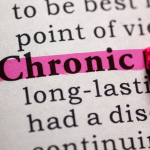Less is Sometimes More: Simple Solutions for a Complex Neurological Case
Tolle Totum
Ashley L. Russell, ND, BCST
While 2017 was winding down, I received the following plea from a woman named Paula, via a Facebook message:
My sister came across your name while searching for the best naturopathic doctors in the area, and you are familiar to me from [networking]. I am in acute need of your services. Just released from 4 days at [the hospital] with continuing debilitating symptoms. Stroke-like symptoms. Stroke ruled out. Had MRIs, CT-scans, cardio work-up, lumbar puncture, etc… The only diagnosis I left with was white matter disease. I have a lap band and think it has led to serious malabsorption issues, etc. I’m grasping, but at this point I’m not functioning, can’t work—can’t drive—can’t stand for long.
Like most of us that go into the healing professions, my heart went out to her, and I quickly arranged a free 15-minute consult to determine if I could possibly help, or to give her some ideas of whom she might consult.
Even though my city is the second-largest in Maryland, there are relatively few naturopathic doctors in the area. We currently have only around 50 for the entire state and are trying, as of this writing – it appears unsuccessfully – for scope expansion to include prescriptive rights.
After listening to her case for a few minutes and hearing the desperation in her voice, I explained to Paula that I had never even heard of white matter disease, but that if she wanted to work with me, I’d be happy to research different naturopathic treatment options. Paula quickly agreed to come in the following week.
What prompted Paula – a white woman in her early 50s – to reach out was the development of stroke-like symptoms a few weeks prior. She had muscle weakness (temporary, thank goodness) and elevated blood pressure. After a battery of tests at the hospital to rule out stroke and multiple sclerosis, they found nothing of note other than “multiple bilateral foci of increased T2 signal in the periventricular and subcortical white matter.” Subsequently, she was diagnosed with “white matter disease” and discharged.
Patient Presentation & History
About 4 days before going to the hospital for her symptoms, Paula had fallen in a parking lot and had an overall sense of extreme fatigue and muscle weakness. When Paula arrived at my office, her gait was slow and she had noticeable tremors in her upper extremities. While she wasn’t currently experiencing muscle weakness, her fatigue was still profound. Her head, in particular, felt extremely heavy, which was helped by lying down. The heaviness was so severe at one point during the visit that we moved to a different room so she could lie down for the rest of the intake. She would also lose her train of thought easily – which occurred a few times during the visit – and she experienced fairly significant aphasia, sometimes using the wrong word in a sentence (eg, “enchilada” instead of “antibiotic”).
Prior to this temporary bout of muscle weakness and fatigue, she was experiencing severe abdominal pain, bloating, and constipation. She would sometimes not have a bowel movement for 10 days at a time. After having had a lumbar puncture as part of her workup at the hospital, she developed a chronic headache, which had not yet abated. Along with her other symptoms, the vision in her eyes was also affected, which made it difficult to focus. Additionally, her hearing would randomly decrease, sometimes to the point where she couldn’t hear at all.
In addition to these newer and more frightening symptoms, Paula reported that the tremors in her upper extremities, which had developed approximately 10 years prior, had significantly worsened. About 7 years ago, in an effort to reduce her weight, she had lap-band surgery. A few years after her surgery, she began experiencing difficulty with word recall, and eventually had a “psychotic break,” which lasted for a few months and ended after being put on a host of medications, including divalproex and lamotrigine (anti-seizure meds), buproprion, trazodone, and a commonly prescribed amphetamine drug. Other relevant history included prediabetes and a pulmonary embolism at 15 years old.
Impressions
From a naturopathic perspective, my primary interest was her poor eating habits. Paula recently had her doctor dilate her lap band so that she could eat more, but what she was eating was concerning. She didn’t like eating fruits or vegetables because of their texture, and she wasn’t a fan of trying new foods. She would only drink diet soda (ie, no water), and mainly consumed different versions of beef and potatoes.
Paula reported that she had a history of smoking and minimal stress. However, she had smoked an entire pack of cigarettes the previous weekend due to her dog suddenly dying in front of her. Upon further questioning, Paula confessed that she was not “body attuned,” and she believed she was having symptoms because of a long-ignored imbalance in her body. This was most likely due to her strong history of abuse.
Interestingly, in spite of her learned disconnect with her body, Paula was aware of a plummeting of “energetic energy” when she had to go out in public, due to noise, lights, etc. It was to the point that she was almost debilitated from going out. Her symptoms were significantly less severe when she stayed home.
Due to the severity of her case and the seemingly ambiguous diagnosis of white matter disease, I suggested Paula see another neurologist for a second opinion. However, since white matter disease involves demyelination and is associated with increased cardiovascular risk, I recommended food antibody testing to identify any food sensitivities that might be contributing to her disease progression.
Treatment & Follow-ups
Since Paula was on multiple medications and was likely nutrient deficient due to her bariatric surgery and diet, our first focus was on improving her nutrition. I referred her to a wonderful occupational therapist, to help with introducing new foods and textures that should ultimately increase her vegetable and fruit intake. I also recommended that she stop drinking diet soda, due to its negative impact on the nervous system, and to replace it with 30 oz of water each day as a starting point.
As for supplements, we started with a multivitamin and fish oil to help supplement nutrients she clearly wasn’t getting from her diet. We also added a probiotic, due to the strong links between gut and nervous system health.1,2 In addition, I thought a homeopathic remedy would help hasten her improvement as we slowly worked on improving her foundations of health. Based on her symptoms of heaviness of the head, aphasia, and tremors, I recommended Phosphoric acid 30C, 3 pellets twice a day.
Because of Paula’s strong motivation and desire to improve quickly, mostly because she was eager to return to work, I also suggested acupuncture and craniosacral therapy as adjunctive modalities.
Five Days Later
We followed up 5 days later by phone. Paula had already scheduled an appointment with a second neurologist. She had also spoken to her psychiatrist in the interim, who strongly believed that nutrition would have no impact on her case and who dismissed a lot of her symptoms, attributing them to panic attacks. Unfortunately, it is not uncommon for me to hear of women’s serious symptomatology being dismissed as “in your head.”
Paula had already experienced some symptomatic improvement when she went to the grocery store and suffered a minor setback. While the store was quiet, once she got to the register, the loud “dings” from the checkout area worsened her tremors, and she had to walk to the back of the store for some time to recover. However, while she was “uncomfortable,” the noise did not aggravate her symptoms as severely as before. Her other symptoms were about the same, but the heaviness of her head was slightly better.
Eighteen Days Later
Two and a half weeks later, Paula came to visit in-person. The second neurologist had diagnosed her with a migraine variant, so Paula had decided to see a third neurologist for another opinion. Her aphasia and tremors were noticeably improved. The feeling of heavy fatigue was gone and her headache was also significantly improved. She had seen the craniosacral therapist in our office for a few sessions, and felt a “huge shift” after each treatment. She was also seeing the occupational therapist, and felt encouraged by the improvement.
I decided to continue the current course of treatment (ie, multivitamin, probiotic, fish oil, and homeopathic remedy, along with some minor nutritional changes), though reduced her Phosphoric acid dose to once per day. We planned to follow up once we had the results of her IgG food antibody panel.
Subsequent Follow-ups
I followed up with Paula 1 month later by phone. She had seen a third neurologist between our visits, who ordered further imaging; she was to follow up with him after our visit. Amazingly, Paula reported she had been completely asymptomatic for the previous 2 weeks, except for a mild return of a few symptoms a few nights earlier. She was happy to report that she was back to working her normal hours, which I suspected caused the brief worsening of symptoms.
We reviewed the results of her IgG food antibody panel, which was highly suggestive of increased intestinal permeability, due to the large number (>20) of foods showing moderate-to-very high antibody levels. Elimination of these reactive foods was coordinated with the occupational therapist. In addition to continuing our previous treatments, a powdered combination of nutraceuticals and herbs was also introduced to help heal the intestinal lining. The only other change was that Paula had decreased the dosing of the Phosphoric acid to more of an as-needed basis.
Later that same day, Paula giddily called to inform me that the third neurologist agreed with my assessment that her disease was nutritional in origin and that she had been having “mini-strokes” that would likely resolve if she continued to improve her diet.
A few follow-ups later, Paula had reintroduced her reactive foods and experienced adverse reactions to gluten, dairy, and sugar. Interestingly, sugar caused her to have temporary aphasia. Other than symptoms experienced during food reintroduction, she had been completely asymptomatic and was still working her normal hours.
In Closing
I last heard from Paula about 9 months after her last visit, again through Facebook, which seemed appropriate, considering how our journey began:
I have long wanted to tell you something. If you remember, my psychiatrist was poo-pooing naturopath[ic medicine] and food effects on the body. Once I stabilized, I scheduled an appointment to show him that my tremors and speech problems (that I’d had for years) were gone. He argued at first, but I Googled gluten and forced him to read. When I left, he looked bewildered.
A couple of weeks later, he emailed me asking where he could refer another client with the same symptoms for naturopathic care.
I thought you’d appreciate hearing that we turned him!
While I sit here feeling discouraged about our impending failure for scope expansion in Maryland this year, I take hope in Paula’s words. Our medicine, as simple as it may sometimes be, is effective and life-giving.
We are an integral part of the healthcare profession at large, as demonstrated by the dramatic improvement in this complicated case. Even while we may be constrained by the state of our licensure or our scope, we still have powerful tools that can have a large impact on our patients’ lives. Our medicine is valuable beyond measure to the patients we help, and one day our licensure in the United States will reflect its true worth.
References:
- Tremlett H, Bauer KC, Appel-Cresswell S, et al. The gut microbiome in human neurological disease: A review. Ann Neurol. 2017;81(3):369–382.
- Fung TC, Olson CA, Hsiao EY. Interactions between the microbiota, immune and nervous systems in health and disease. Nature Neurosci. 2017;20(2):145-155.
 Ashley L. Russell, ND, BCST, is owner and naturopathic doctor at Frederick Natural Health Center in Frederick, MD. She is currently writing her first book, Reclaim Your Cycle: The savvy woman’s guide to naturally balance your hormones to live a PMS-free and energy-filled life. Dr Russell is currently adjunct faculty at Frederick Community College, teaching nutrition, anatomy, and physiology. She has previously taught biochemistry and genetics. In her spare time, Dr Russell enjoys baking vegan, gluten-free treats, knitting, curling up with a good book, and spending time with her dog, Honey, and partner, Mark.
Ashley L. Russell, ND, BCST, is owner and naturopathic doctor at Frederick Natural Health Center in Frederick, MD. She is currently writing her first book, Reclaim Your Cycle: The savvy woman’s guide to naturally balance your hormones to live a PMS-free and energy-filled life. Dr Russell is currently adjunct faculty at Frederick Community College, teaching nutrition, anatomy, and physiology. She has previously taught biochemistry and genetics. In her spare time, Dr Russell enjoys baking vegan, gluten-free treats, knitting, curling up with a good book, and spending time with her dog, Honey, and partner, Mark.









